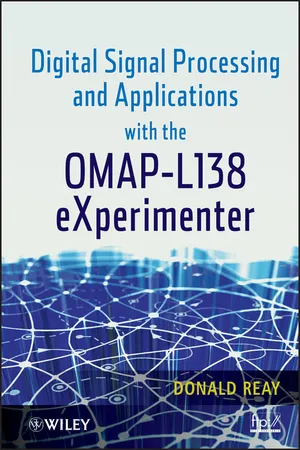
Digital Signal Processing and Applications with the OMAP - L138 eXperimenter
- English
- ePUB (mobile friendly)
- Available on iOS & Android
Digital Signal Processing and Applications with the OMAP - L138 eXperimenter
About this book
The OMAP-L138 eXperimenter is the latest inexpensive DSP development system to be adopted by the Texas Instruments University Program. The OMAP-L138 processor contains both ARM and DSP cores and is aimed at portable and mobile multimedia applications. This book concentrates on the demonstration of real-time DSP algorithms implemented on its C6748 DSP core.
Digital Signal Processing and Applications with the OMAP-L138 eXperimenter provides an extensive and comprehensive set of program examples to aid instructors in teaching DSP in a laboratory using audio frequency signals—making it an ideal text for DSP courses at senior undergraduate and postgraduate levels.
Subjects covered include polling-based, interrupt-based, and DMA-based I/O methods, and how real-time programs may be run using the board support library (BSL), the DSP/BIOS real-time operating system, or the DSP/BIOS Platform Support Package.
Chapters include:
-
Analog input and output with the OMAP-L138 eXperimenter
-
Finite impulse response filters
-
Infinite impulse response filters
-
Fast Fourier transform
-
Adaptive filters
-
DSP/BIOS and platform support package
Each chapter begins with a review of background theory and then presents a number of real-time program examples to reinforce understanding of that theory and to demonstrate the use of the OMAP-L138 eXperimenter and Texas Instruments Code Composer Studio integrated development environment.
Frequently asked questions
- Essential is ideal for learners and professionals who enjoy exploring a wide range of subjects. Access the Essential Library with 800,000+ trusted titles and best-sellers across business, personal growth, and the humanities. Includes unlimited reading time and Standard Read Aloud voice.
- Complete: Perfect for advanced learners and researchers needing full, unrestricted access. Unlock 1.4M+ books across hundreds of subjects, including academic and specialized titles. The Complete Plan also includes advanced features like Premium Read Aloud and Research Assistant.
Please note we cannot support devices running on iOS 13 and Android 7 or earlier. Learn more about using the app.
Information
- OMAP-L138 processor
- Code Composer Studio™ IDE version 4
- Use of the OMAP-L138 eXperimenter
- Programming examples


Table of contents
- Cover
- Title Page
- Copyright
- Dedication
- Preface
- List of Examples
- Chapter 1: OMAP-L138 Development System
- Chapter 2: Analog Input and Output with the OMAP-L138 eXperimenter
- Chapter 3: Finite Impulse Response Filters
- Chapter 4: Infinite Impulse Response Filters
- Chapter 5: Fast Fourier Transform
- Chapter 6: Adaptive Filters
- Chapter 7: DSP/BIOS and Platform Support Package
- Index
- Eula